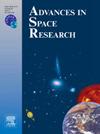On-orbit assembly control based on model predictive control and load online identification
IF 2.8
3区 地球科学
Q2 ASTRONOMY & ASTROPHYSICS
引用次数: 0
Abstract
Space manipulator are essential for on-orbit assembly (OOA) tasks. This paper proposes an advanced control framework to address key challenges in Cartesian trajectory tracking and compliant assembly. First, a rigid-body dynamic model of the manipulator is established using CAD model and joint friction identification. A Linear Extended State Observer (LESO) is designed to mitigate system errors by modeling both parametric uncertainties and external disturbances as an extended state. Additionally, the method for selecting parameters of the LESO, along with its convergence proof, is presented. Second, a model predictive control (MPC) algorithm is employed to optimize the Cartesian trajectory of the manipulator in real time. By linearizing the Cartesian space trajectory, the MPC problem is formulated as a QP problem. Solving this QP problem in real-time allows for the optimization of the Cartesian space trajectory, thereby improving the trajectory tracking accuracy in Cartesian space. Finally, online identification of load parameters, sensor zero drift, and temperature drift enables effective compliant assembly control. Extensive experiments validate the proposed methods: (1) The Cartesian trajectory tracking error is maintained below 0.1 mm. (2) After sensor compensation for identified load parameters, zero drift, and temperature drift, the maximum force residual is 0.42 N, and the maximum torque residual is 0.1 N m.
基于模型预测控制和负荷在线辨识的在轨装配控制
空间机械臂是在轨装配任务的重要组成部分。本文提出了一种先进的控制框架,以解决笛卡尔轨迹跟踪和柔性装配中的关键挑战。首先,利用CAD模型和关节摩擦辨识建立了机械臂的刚体动力学模型;线性扩展状态观测器(LESO)通过将参数不确定性和外部干扰建模为扩展状态来减小系统误差。此外,给出了LESO的参数选择方法及其收敛性证明。其次,采用模型预测控制(MPC)算法实时优化机械臂的笛卡尔轨迹;通过线性化笛卡尔空间轨迹,将MPC问题化为QP问题。实时求解该QP问题,可以对笛卡尔空间轨迹进行优化,从而提高在笛卡尔空间中的轨迹跟踪精度。最后,在线识别负载参数、传感器零点漂移和温度漂移,实现有效的装配控制。大量的实验验证了所提出的方法:(1)将笛卡尔轨迹跟踪误差保持在0.1 mm以下。(2)传感器对识别的负载参数、零漂移和温度漂移进行补偿后,最大残余力为0.42 N,最大残余扭矩为0.1 N m。
本文章由计算机程序翻译,如有差异,请以英文原文为准。
求助全文
约1分钟内获得全文
求助全文
来源期刊

Advances in Space Research
地学天文-地球科学综合
CiteScore
5.20
自引率
11.50%
发文量
800
审稿时长
5.8 months
期刊介绍:
The COSPAR publication Advances in Space Research (ASR) is an open journal covering all areas of space research including: space studies of the Earth''s surface, meteorology, climate, the Earth-Moon system, planets and small bodies of the solar system, upper atmospheres, ionospheres and magnetospheres of the Earth and planets including reference atmospheres, space plasmas in the solar system, astrophysics from space, materials sciences in space, fundamental physics in space, space debris, space weather, Earth observations of space phenomena, etc.
NB: Please note that manuscripts related to life sciences as related to space are no more accepted for submission to Advances in Space Research. Such manuscripts should now be submitted to the new COSPAR Journal Life Sciences in Space Research (LSSR).
All submissions are reviewed by two scientists in the field. COSPAR is an interdisciplinary scientific organization concerned with the progress of space research on an international scale. Operating under the rules of ICSU, COSPAR ignores political considerations and considers all questions solely from the scientific viewpoint.
 求助内容:
求助内容: 应助结果提醒方式:
应助结果提醒方式:


